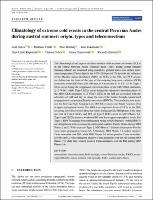Climatology of extreme cold events in the central Peruvian Andes during austral summer: origin, types and teleconnections

Metadatos
Mostrar el registro completo del ítemResumen
The climatological and large‐scale characteristics of the extreme cold events (ECEs) in the central Peruvian Andes (Mantaro basin (MB)) during austral summer (January–March) are examined using reanalysis, gridded and in situ surface minimum temperature (Tmin) data for the 1979–2010 period.
To describe the influence of the Madden–Julian Oscillation (MJO) on ECEs in the MB, two ECE groups are defined on the basis of the sign of the outgoing long‐wave radiation (OLR) anomalies in the MJO band (30–100 days, 0–9 eastward) at 12.5°S, 75°W. Type‐1 ECEs occur during the suppressed convection phase of the MJO (OLR anomalies ≥+2 W/m2) while Type‐2 ECEs occur during the enhanced convection phase of the MJO (OLR anomalies ≤−2 W/m2).
ECEs in the MB are associated with the advection of cold and dry air along the east of the Andes through equatorward propagation of extratropical Rossby wave trains (ERWTs). This cold advection weakens the Bolivian High–Nordeste Low (BH‐NL) system over South America (SA) at upper‐tropospheric levels.
The MJO is an important driver of ECEs in the MB, favouring the cold advection along the Andes during specific MJO phases. Fifty‐nine per cent of Type‐1 ECE's and 86% of Type‐2 ECE's occur in MJO Phases 7‐2. Type‐1 and 2 ECEs feature a weakened BH over SA at upper‐tropospheric levels. For Type‐1, ERWTs emanate from southeastern Africa in MJO Phases 8‐1 while ERWTs are strengthened when crossing the subtropical southern Pacific Ocean during MJO Phases 2 and 7. With respect to Type‐2, MJO Phases 7‐2 feature circumpolar Rossby wave trains propagating toward SA.
Ultimately, MJO Phases 7‐2 induce negative Tmin anomalies over MB, while MJO Phases 3‐6 induce positive Tmin anomalies. El Niño and La Niña strengthen negative Tmin anomalies over the MB during MJO Phases 7‐8 while they weaken positive Tmin anomalies over the MB during MJO Phases 3‐6.
El ítem tiene asociados los siguientes ficheros de licencia:







